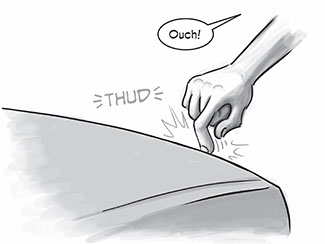SciGen Teacher Dashboard
Unit E1
Potential and Kinetic Energy
Lesson: Get a Grip on Gravity
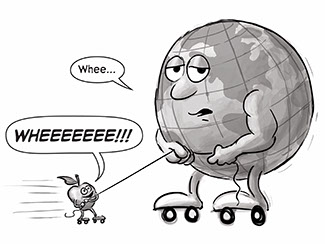 Duration: Approximately 60 minutes
Duration: Approximately 60 minutes
Get a "grip" on gravity through this illustrated guide.
LEARNING OBJECTIVES
Students will develop knowledge about gravity and address common misconceptions..
Students will construct and present arguments using evidence to support the claim that gravitational interactions are attractive and depend on the masses of interacting objects.
Teacher Tips
- Gravity is a topic full of misconceptions that are hard to dislodge from students' minds. You may have a hard time wrapping your head around it yourself. Acknowledging this dilemma may help the students come to the content with fresh ears and eyes.
Teacher Tune-ups
Teaching Notes
ACTIVITY OVERVIEW
- Consider the definition (10 minutes)
- Aristotle wrong? (15 minutes)
- Galileo gets it? (15 minutes)
- Newton nails it? (10 minutes)
- Introduce inertia (10 minutes)
Consider the definition (10 minutes)
:
People have struggled to understand gravity for many centuries, but Aristotle, Galileo, and Newton are three important people who thought about it differently and made interesting observations.
Show students the definition of gravity to the right. Encourage them to ask questions about gravity and what the basic definition means.
Gravity n.
A force that acts between all masses, pulling them together.
Is the definition helpful?
- Sort of.
- Not really.
- Seriously?
Aristotle wrong? (15 minutes)
Read and discuss the passage to the right with the class.
When discussing, have students offer a variety of ideas.
Allow students to drop books and single sheets of paper.
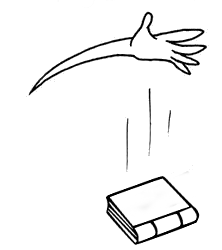 All through history people have asked the same questions, like “What's for dinner?” and “Why do things fall?” Aristotle, who lived in Athens almost 2,500 years ago, argued that the center of the Earth was the center of the universe. So naturally everything tended to fall in that direction! Wrong on TWO counts. He also thought that heavier things fell faster than lighter things. Well, you could see how he would think that. Try dropping a piece of paper and a book. The book hit the floor first, right? But not because of gravity and not because it is heavier.
All through history people have asked the same questions, like “What's for dinner?” and “Why do things fall?” Aristotle, who lived in Athens almost 2,500 years ago, argued that the center of the Earth was the center of the universe. So naturally everything tended to fall in that direction! Wrong on TWO counts. He also thought that heavier things fell faster than lighter things. Well, you could see how he would think that. Try dropping a piece of paper and a book. The book hit the floor first, right? But not because of gravity and not because it is heavier.
Discuss.
Galileo gets it? (15 minutes)
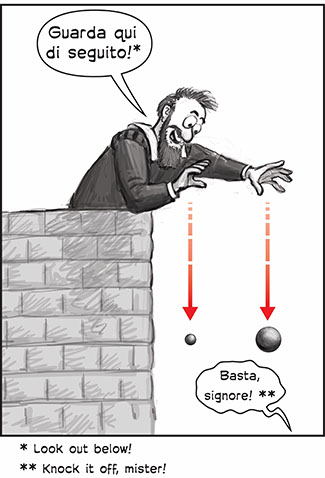
Here is where Galileo comes in. He carefully dropped balls from towers and rolled them down inclines. He stated that the reason your book drops faster than your paper is not due to their difference in mass, but rather because air resistance (friction) affects the falls differently.
Let's explore Galileo’s idea.
Step 1: Go to the moon where there is no air to affect the way things fall.
Step 2: Drop a feather and a hammer at the same time.
Oh, going to moon is not in your budget? Well, watch this video of an astronaut who tried it out in 1971:
Read and discuss the passage to the right with the class.
View and discuss NASA video.
Discuss.
Newton nails it? (10 minutes)
Read and discuss the passage to the right with the class.

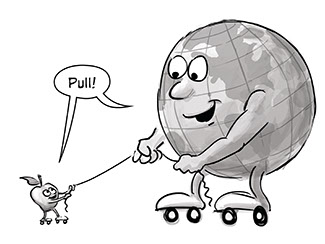 As great as Galileo was, Isaac Newton was the one who really hit it out of the park with this idea: he said that gravity is not just about the Earth pulling things, but rather that everything that has mass creates a gravitational force.
As great as Galileo was, Isaac Newton was the one who really hit it out of the park with this idea: he said that gravity is not just about the Earth pulling things, but rather that everything that has mass creates a gravitational force.
Consider an apple and the planet Earth.
Newton said that the apple is pulling on the Earth in exactly the same way as the Earth is pulling on the apple.
Huh?
Then, you might ask, “Why doesn’t the Earth fall up to the apple?” Well, the answer to that is...
It does.
Huh??
Just not very much. Actually, it’s an immeasurably small distance.
So, how can the apple and the Earth react to equal forces so differently?
Introducing inertia (plus acceleration and velocity) (10 minutes)
Show the images to the right.
:
- Think about flicking a paper clip with your fingers.
- Think about flicking a parked car with your fingers.
:
- Why wouldn’t the car move as much as the paper clip??
After an appropriate amount of discussion, present the "ANSWER" but have them address the associated question.
Finally, for continued study of this subject assign students the following reading. It includes everything discussed thus far and continues on to introduce inertia, acceleration, and velocity.
ANSWER: INERTIA.
Massive things have more mass (duh!), more gravitational force, and more inertia. If you think that car was hard to move with a flick of your fingers, just imagine how tough it would be for the apple’s gravitational field to yank the Earth up to it. Not gonna happen!
One more question:
Is the acceleration of the apple dropping to the Earth
- greater than
- less than
- about the same as
the acceleration of the Earth up to the apple?
Greater than, of course! You can definitely observe that.
But why?

BETA Version - Please send comments and corrections to info@serpinstitute.org
